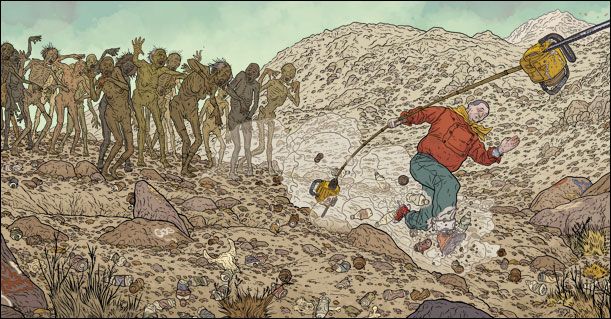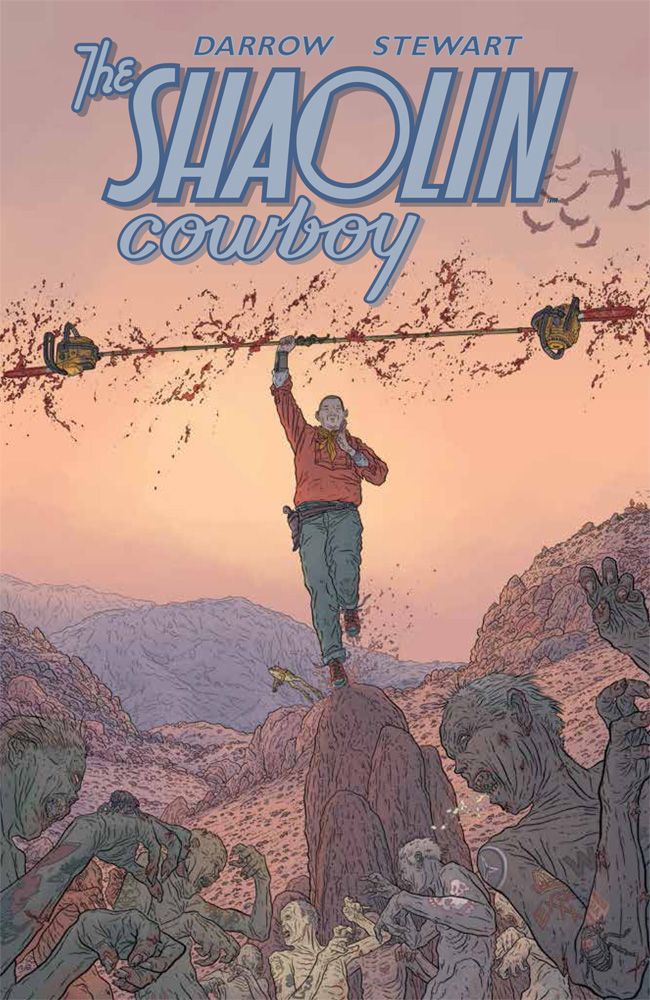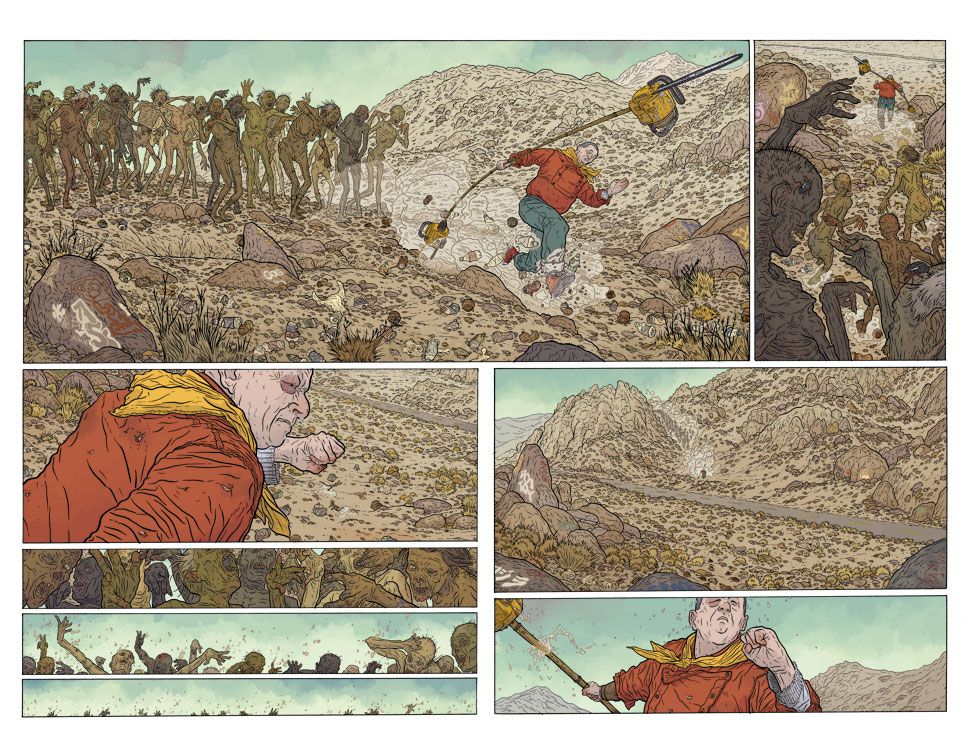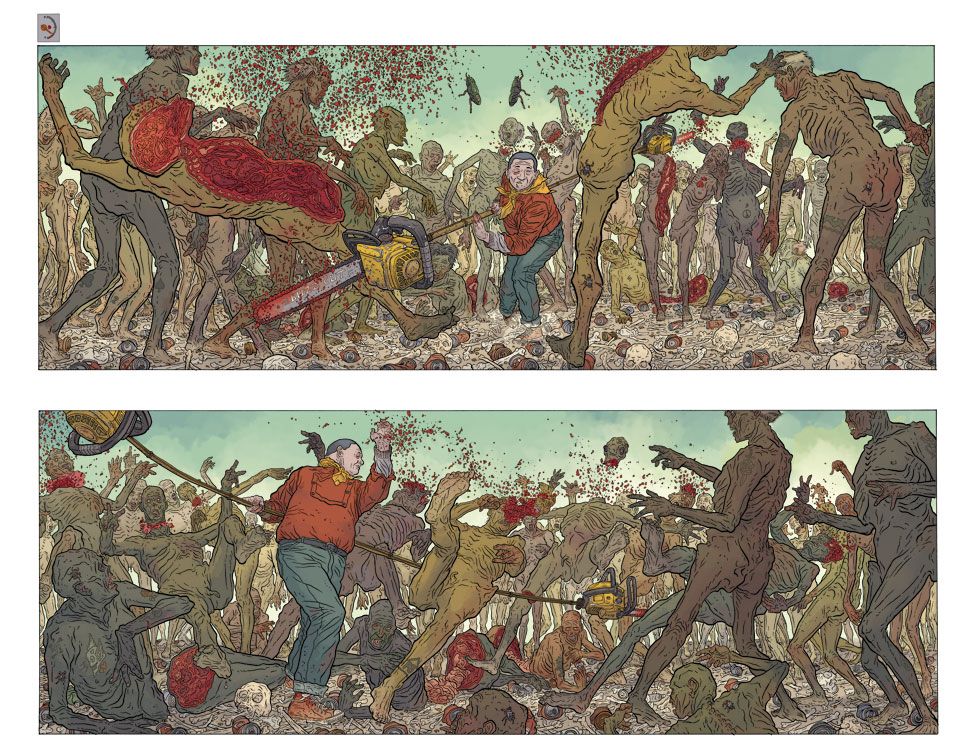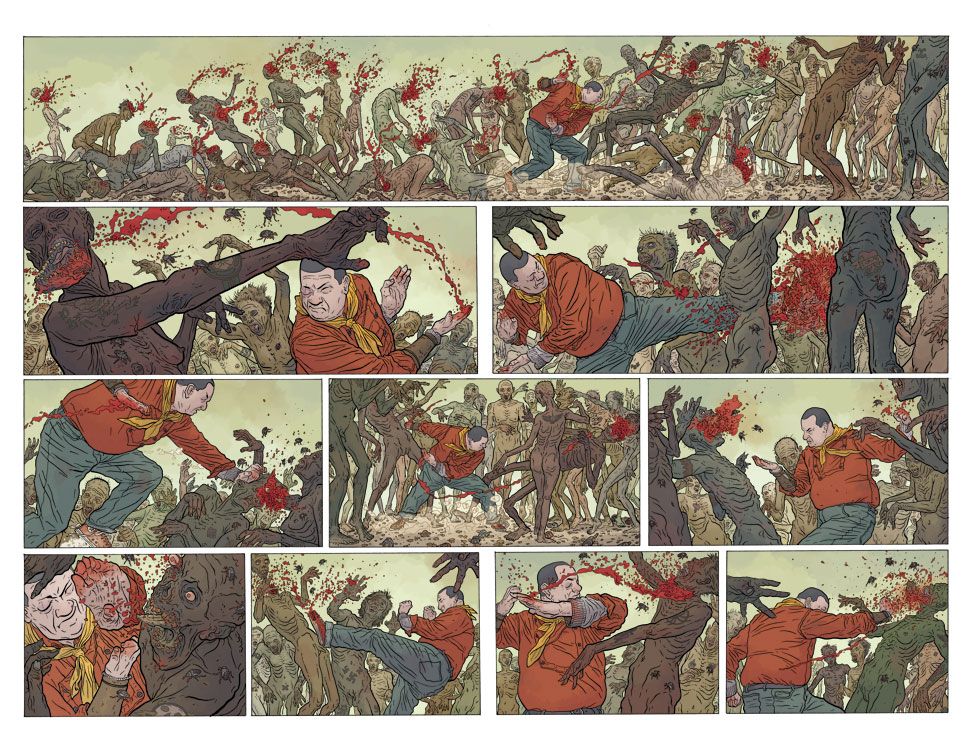Fans of Geof Darrow get ready -- Dark Horse Comics has three long out-of-print collections coming down the line. Not only will Darrow and Frank Miller's "Big Guy and Rusty the Boy Robot" receive a fancy new Gallery Edition, but "Bourbon Thret" -- Darrow's first published comics work previously only available in French -- will arrive in its first English translation, and his critically acclaimed "Shaolin Cowboy" will be collected for the first time ever in America.
Working in comics since the 1980s, Geof Darrow spent much of his career in France, breaking into comics there and going on to work in many different artistic fields -- including an animation job with Hanna Barbara and design work with the Wachowskis on "The Matrix" -- all while publishing more work, including "Hard Boiled" with Frank Miller.
CBR News spoke with Darrow about his upcoming reprints as well as his career as a whole, and the creator discussed working at Hanna Barbara at the same time as Jack Kirby, the continuing love for the short-lived "Big Guy and Rusty" animated series, the negative reviews he finds hilarious and how the industry has changed and evolved since he began in the '80s. Plus, he teases the first new "Big Guy and Rusty" story coming soon to Dark Horse.
CBR News: Geof, looking at "Bourbon Thret," this will likely be the first time many American readers have the opportunity to read the series -- which is your first published piece in comics. How did that project influence the other projects you've done throughout your career?
Geof Darrow: It was just the first thing. I was trying to figure out -- I still am trying to figure out -- how to tell and draw a story the way you want to tell it and what you want your particular vision to be -- if that's not being pretentious. I was working a lot of stuff out with that comic book and I was fortunate enough to get to do it. I wanted to work in French comics, I was living over there and I got a chance to do it.
Well, it seems like you still have a pretty big connection to French comics. In addition to "Bourbon Thret," "Shaolin Cowboy" was collected in trade paperback there -- and this new Dark Horse printing is the first time both had been collected in the states. Do you still feel like you still have a heavy connection to French comics, considering that's where you got your start?
Yeah, that's why I went over there. I'd seen a book by Maurice Horn called "Comic Strips of the World," and the one that struck me particularly was this western called Lieutenant Blueberry by this guy Jean Giraud [also known as Moebius]. They talked about him and I was fascinated by his drawing. Back in the '70s, Bud Plant used to import French albums. They weren't that expensive, and I just remember sending for one by him and this gentleman Jean-Claude Mezieres called "The Valerian." I was just amazed by the level of drawing in those books. I became a huge fan of it, trying to find these things. Whenever I'd go to another city, I'd go to the yellow pages to see if there was a foreign library, and if I could find some books there, I did.
I was a Marvel guy, and I still am to a certain extent, but at the time, I was a French comics guy. I guess I still am. I follow a lot of the work over there.
For something like "Bourbon Thret," what was it like for you to take a look back at the very beginnings of your work in professional comics?
I haven't yet! [Laughs] To be quite honest, I have the material, but just haven't gone through it. It's frightening, actually. You look at this stuff and you realize, "Wow, I really put a lot of work into this. I wonder why?" [Laughs] Some of it was for ridiculous reasons. I don't like looking at my stuff because it frightens me. I always see the many inadequacies in what I do.
Sometimes I'm not really happy with the color, which is why on "Big Guy," I'm having it re-done. I was never really happy with the color, so I'm going to have Dave Stewart -- he's fantastic -- re-do it. He's very smart. I say, "Oh, could this be this color?" and he -- to use a sports metaphor -- he's like Babe Ruth. He hits it out of the park every time. I'm just amazed at how intuitive about what I want [he is]. We had one conversation about it and now he just does it. It makes me very happy.
"Big Guy and Rusty" struck a particular chord with readers, as many became familiar with the series through the animated television show.
It's amazing. It wasn't on that long, and it was pretty sporadic -- but I'm surprised at how many people come up to me and really love that show, and wish they could get it on DVD or some sort of platform. But that's out of my hands.
What do you think it is about the characters and your designs that make the book strike such a chord with readers?
I think it's the familiarity. It's the Batman/Robin relationship, except Big Guy doesn't want a Robin. I mean, there's only really one story! [Laughs] Now, there's another one, but it doesn't really change much. I think the Big Guy could get careless about having him around. Frank [Miller] and I always talked about doing others where in every one, he was going to get destroyed and the Japanese were going to keep rebuilding him and annoying the heck out of him, because he doesn't want another -- he doesn't want him flying around! He's like a pesky gnat.
I don't know, the designs are kind of '50s. When I talked to Frank, he said [Big Guy] should look like an old '50s refrigerator with white enamel and chrome. Rusty's a fairly simple design, he's easier to draw. I thought Big Guy would be easier, but there's a lot of concentric circles and ellipses that are somewhat trying to do.
"Shaolin Cowboy" is one of your more recent works, and I remember reading in an interview that you believe all stories at their core are American Western stories.
Yeah, I do.
But "Shaolin Cowboy" seems to have an especially strong tether to that genre, not just because it has the word "Cowboy" in the title.
Well, especially the last one, it's fairly obvious that it's in the American southwest, kind of my weird version of it. I always think of the cowboy that comes into town, cleans things up and then rides out. Even those "Die Hard" movies, I thought it was funny he said, "Yippie ki-yay." Whenever anybody takes things on their own to find a solution -- generally a violent one -- they're generally called cowboys. It's seen both positively and negatively. Ronald Reagan was considered a cowboy, and I was never a big fan of Mr. Reagan -- or Mr. Bush, who were cowboys in their own right. It's okay in comic books, but on the world stage, it's not a very good idea. [Laughs]
With "Shaolin Cowboy," getting collected, was it a story you always envisioned reading better as a whole or in serialized pieces?
In general, when it started out in Burlyman, it was a really long story. I think that is coming out before the Dark Horse one. But I wasn't really able to finish it for reasons that I won't go into, so it's just kind of out there. There's a lot that goes on between the end of that one and the one I did at Dark Horse. If you read the last issue of the Burlyman one, you can see where all those things came from -- those creatures, those zombies. Not that there's a lot going on, which I've been criticized for. [Laughs]
You've also had a long and interesting career outside comics. You were an animator at Hanna Barbera for a while, and even got to work with Jack Kirby while he was there.
Oh yeah! He came to the office and sat on my desk. I kept the pencil he used for the longest time. I got to meet him, and he would come in every week. He was so fast that we joked around -- he did character designs on all the shows, everything from "Superfriends" to "Scooby Doo" -- that he just did them in the car on the way in! They were really something, all really beautiful, but some of them were really funny. He'd do spaceships, and I remember [us saying], "Geez, this is a Nikon camera!" But he was one of the most sweet guys you'd ever want to run into. His door was open to everybody.
Do you still have the pencil?
Oh, no. I had it in an envelope and wrote, "Jack's pencil." Maybe it's somewhere in a box. I wish it was because it was one of those things where [I think], "Oh, there's got to be some magic in that pencil now!"
After your experience working in animation, was there ever any reluctance you had about turning "Big Guy and Rusty" into an animated series?
I think it worried Frank more than me. I have no problems with any sort of adaptations. If they're good, everyone says, "Oh, they made a great cartoon of your work" -- or movie. If it's bad, they say, "Oh they did a crappy job of [adapting] your great comic book." [Laughs] So, they never blame the source material. You'll get credit when it's good, but you don't get credit when it's bad. I think it bothered Frank a little more. At the beginning, Mike Richardson fought for [us]. They were going to turn [Big Guy] into Robocop, because they didn't want him working for the army and I remember them fighting. I told [Mike], "You can tell them from me that if they do that, I will do one issue of the comic that will be so repulsive that it will cause a lot of bad publicity and it'll throw a lot of stink on the show." [Laughs] I doubt it had anything to do with it. It mostly had to do with Mike and someone else at Fox saying, "We want the comic book." So, it got switched back.
I was living in France at the time, so I've ever seen one episode of it.
Did you like the episode that you saw?
Yeah! They premiered it at San Diego Comic-Con. I remember sitting there watching it, and I remember telling them -- they asked me what I wanted -- I wanted there to be a theme song. I wanted there to be something like [Sings] "Big Guy with his guns ablaze!" I don't know what I was riffing on at the time. He had to have a theme song, because I liked all those old cartoons that had a theme song, like Gigantor, "bigger than big, stronger than strong." And they did! I thought the theme song was a riot.
Having been in the industry for a long time, how do you feel you've evolved as an artist over time?
I don't know. I just try to get better. I don't know if people like what I do, but you can't say that I don't put effort into it, because I do try my hardest! [Laughs] I read some reviews of the last series that I did and some were -- yikes! If they didn't like it, okay, but they were complaining about the drawing. I thought I worked pretty hard on it!
I think my favorite review -- and I was going to put it on a solicitation for Dark Horse, because I'm not really big on the self-congratulatory stuff. One of the reviewers really disliked it, she said, "It's the comic book equivalent of [The Lonely Island's] 'Threw It On The Ground'!" [Laughs] I took that as a huge compliment! I thought that was great. But this is the best -- this guy called the Comic Pusher said, "This feels like simple, hollow artistic masturbation in four colors, stapled with a bar code with the suckers to lose $3.50 on." It was actually $3.99. And I wanted to put that in the solicitations! They said, "Well, no. People might not buy it." I thought they were funny. Although, that guy -- the lede of the piece was "Why the 'Shaolin Cowboy' is a bad comic." Yikes! [Laughs]
You'll get that -- you'll get people that come up to tell you that at the conventions. I would never do that to anybody. I'm sure there are other issues, reason why they're doing it. But standing in line to tell you how shitty you are? Thanks! You're right! I'm going to work for Orkin now. [Laughs]
You've had the opportunity to really see comics grow as an industry. What's your take on how comics have grown and changed since you began working in the '80s?
I'm such an odd guy because I was overseas for most of it. I wasn't even in the country when "Hard Boiled" came out -- or "Big Guy." "Shaolin Cowboy" is the first comic I've done in the United States where I was actually in the country when it came out. I don't know. It's odd.
San Diego Comic-Con is more of a movie [show] -- it's what they call it: a celebration of the cultural arts. I remember when I used to go and it was a comic convention. I think the only guests there were the gentleman that played the inspector in "Superman," or Noel Neill, who was Lois Lane. That was about the size of it. You could just walk in the door. I even remember seeing Alan Moore there. There were maybe 10 people at his table. Now, it's just -- my God! The lines of people.
In terms of the industry, when I started out, a guy who drew like I did could not get a job in comics. I remember showing my stuff to Archie Goodwin and he liked it, but said, "I wouldn't know what to do with it," because it didn't fit into anything. Now, it's amazing -- you've got David Aja and Paul Pope and Mike Mignola and Skottie Young -- all these guys are drawing Marvel Comics or mainstream comics and they don't fit into DC or Marvel's style when I started out in the '60s and '70s. It doesn't matter what the style is any more, which I think is great.
You mentioned earlier that you're a Marvel fan. Is that something you would ever want to do, draw a Marvel comic?
Yeah, I always think about it. I get right up to the edge of that cliff, but I've never jumped off. I'd like to do one of them, I know I'm talking to them to do some Hulk covers, because I've never done what I consider to be the big characters -- which are the Avengers guys: Iron Man, Thor, the Hulk, Captain America, the Fantastic Four and Spider-Man were the main guys for me. I did Daredevil covers a couple of times, but he was never for me until Frank was doing him. I liked them all, though. I guess it's putting that much effort into something that I don't own is hard for me.
I remember when Moebius was doing "Silver Surfer," he and I went to see Frank Miller and we all went out to dinner. As we were talking about it, Moebius said he was having a hard time [with the "Silver Surfer"]. He said, "You know, I've always wanted to draw a Marvel comic book. It was a wish I had in my pocket. I would look at it every once in a while and put it back. Maybe I should have left it in my pocket." It was hard for him, I think, to put himself in that type of world. He was so used to doing his own thing. I kind of understand what he means.
Beyond the reprints coming up, what else is in the pipeline for you?
I'm working on other "Shaolin" -- I was de-railed, because Mike Richardson kept bugging me to draw the Big Guy. I'd always wanted to do another one, and I had another idea for what it would be. Mike wanted it, and he's always been really good to me, so I said, "Okay." [Laughs] So, I did it. I don't know what people are going to think of it. It's about nine pages, it's not a big deal. It's a little episode -- it's got monsters and people. It's not "Saga" or "The Walking Dead" -- it's just a guy fighting a monster!
That's what comic books were to me -- people resolving conflicts. There are all sorts of comics you can do, but I always liked that part of it, like when the Hulk fought Thor, and Thor had 60 seconds to find his hammer because he dropped it. That's for me. I'm not Dostoevsky or Jacqueline Susann, or whoever that knucklehead who does "Twilight" is.
I think that whole thing is frightening. I argue with my daughter -- because she's a teenager -- with her friends, because they go, "I'd be a vampire! What's the downside? There's no downside!" I don't get it! They've taken all the horribleness out of it.
Joss Whedon treated it really well in "Buffy," but it really annoys me that there's a whole new type of vampire -- a glittery vampire. That's probably going to end up being the way zombies were originally -- shambling forms of cheap labor, which is what they were, supposedly. [Laughs] Now, thanks to George Romero -- and I thank him because they're much more interesting -- they're brain-eating creatures.

